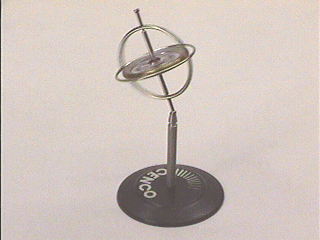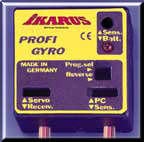
This project is based on the reflections by J. Borenstein and L.Feng, University of Michigan, June 27, 1996, Gyrodometry: A New Method for Combining Data from Gyros and Odometry in Mobile Robots.

Here two sites explaining well how gyroscopes work.
http://www.geocities.com/CapeCanaveral/2188/main.html
http://www.howstuffworks.com/gyroscope.htm
IKARUS Profi-Gyro

This German gyro is normally used in model-helicopters.
It has a lot of interesting features: normal use for reaction to direction changes, heading-lock use, electronical sensitivity change, temperature compensation, control-LED, reverse motor
| Ambient temperature | -10 bis +50 ° C |
| applied voltage | 3,5-12 Volt |
| weight | ca. 24 gr. |
| dimensions | ca. 41x38x16.5 mm |
| possibility to read analog sensor-values | 360° 1 / 255 resolution (not specified by IKARUS) |
| servo control by | 1,0 - 2,0 msec impulses |
| pause between impulses | 14 - 25 msec |
| typical drift | 0.20° / min |
The gyro works with the ceramic gyro sensor from Tokin. When applying rotational angle velocity to an oscillating object, perpendicular to the oscillation direction a physical force is generated. The Tokin sensor uses this physical phenomenum.